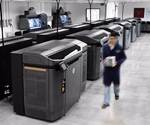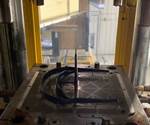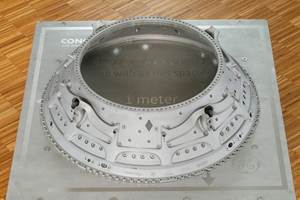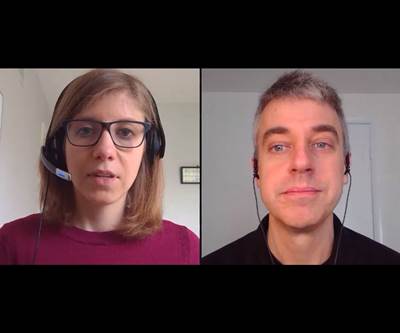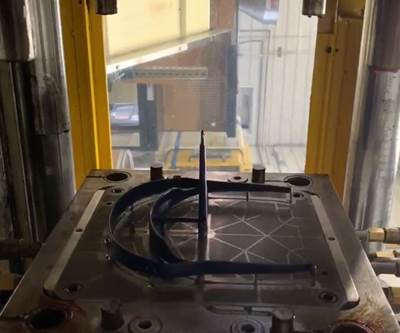A Hospital's Perspective: TriHealth Receives PPE with 3D Printed Components
A face shield solution developed by GE Additive is now in use at Cincinnati-area hospitals. A combination of 3D printed adapters and off-the-shelf shields and hard hats makes this PPE fully reusable.
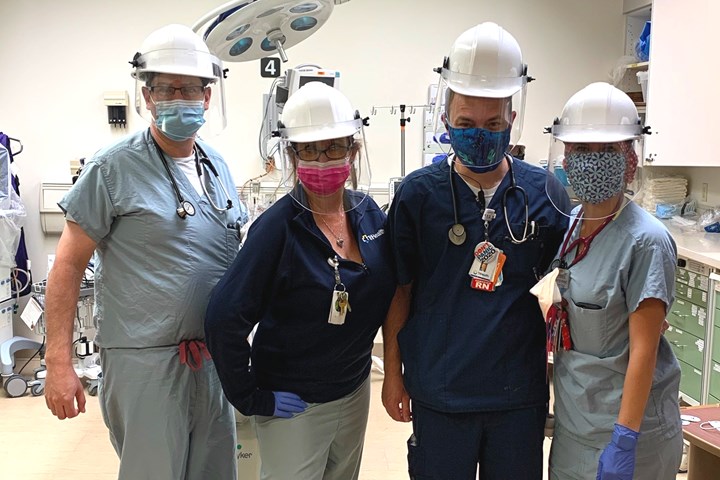
GE Additive created 3D printed adapters to attach face shields to these hard hats currently in use at the TriHealth hospital system in Cincinnati. Pictured are Dr. Jared Lifshitz, Katie Stegman, Curt Rowland and Emmalee Hollowell. Photo: TriHealth
Director of Lean Mike Waterman leads the process improvement team at the TriHealth hospital system in Cincinnati in projects that help hospitals reduce waste and operate more efficiently. Under normal circumstances, a typical day might involve anything from standardizing the way that trays of surgical instruments are laid out in the operating room, to improving on-time delivery of patient meals. Lately, though, process improvement has been largely occupied by one thing: personal protective equipment (PPE), the critical items needed to protect healthcare workers treating patients with COVID-19.
“Based on what’s happening in the state of Ohio, we’re projecting what our patient volumes would be, and working backwards to days on hand of critical resources,” Waterman says. The process improvement and supply chain teams are working closely to track and forecast these numbers, he says. “We’re calculating the daily per-patient utilization of things like isolation gowns, face shields, surgical masks, N95 masks and gloves so that we know where to focus our purchasing efforts to make sure we have sufficient PPE for the system.”
Ensuring sufficient PPE is about more than raw numbers. In addition to assessing current quantities in stock, Waterman is also taking into account which items can be sterilized and reused, and for how long; any stock that could be retrofitted (like a supply of N95 masks with worn-out elastic that needed to be replaced before they could be used); and how to extend the lifespan of the existing supply.
“Of the products we track, N95 masks are our biggest challenge right now. That’s where the face shields come in handy.”
“Of the products we track, N95 masks are our biggest challenge right now,” Waterman says. “That’s where the face shields come in handy. If you have the face shield on, that extends the life of that N95 mask. Maybe you can use it all day, instead of just one procedure, or multiple days instead of one day.”
Finding a Local Solution
Recognizing this need, TriHealth went so far as to order 350 nonclinical plastic shields from an industrial supply company, but it wasn’t able to source the headgear to hold them. When TriHealth got word that GE Additive (headquartered in Cincinnati) wanted to help with needs related to COVID-19, Waterman brought one of the shields to the company. He asked if GE could print the head piece, similar to the other 3D printed visor designs already in circulation. However, that’s not the solution their conversation produced.
“We just happened to have a hard hat in the area where we were meeting,” Waterman recounts. “Somebody grabbed it and asked, ‘How can we attach the shield to this?’ That’s where they came up with the hinge idea.”

The adapters snap into the universal tabs found on all hard hats, and wingnuts secure the shield. Image: GE Additive
What GE Additive developed is a 3D printed ABS adapter that fits into tabs on either side of a hard hat and holds the shield in place with two wing nuts. The adapters use much less material than a full visor would, and thus can be printed faster and at lower cost. Once printing is complete, the adapters and faceshield can be attached to the hard hat in under a minute. And, the adapters are compatible with any hard hat.
“Unbeknownst to us at that time, the point where the hinge clicks in is a universal spot on all hard hats,” Waterman says. “You can buy any hard hat and this will work with it.” The model chosen by TriHealth has a bill long enough to meet the shield, protecting the wearer from any aerosols from above without needing any additional 3D printed pieces.
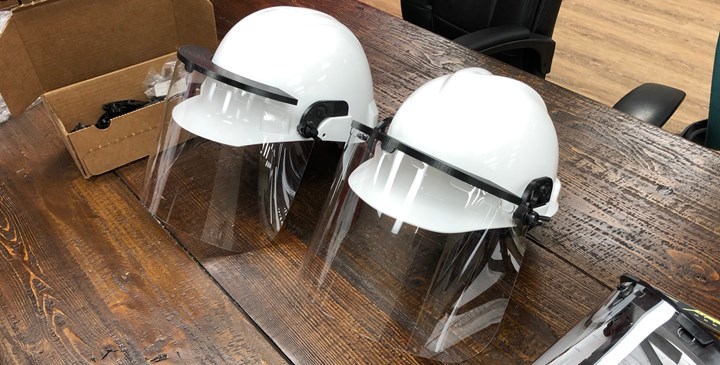
Some earlier designs included a 3D printed component to enclose the top of the shield. TriHealth was able to purchase hard hats with bills long enough to avoid the need for this extra piece. Photo: GE Additive
Effective and Reusable PPE
The adapter design is not just a manufacturing win; it makes logistical sense for the TriHealth system, and may actually be a more effective solution against the coronavirus than a face shield attached to a visor. The closed-cell foam used in many of these visors for wearer comfort can be a potential problem — the adhesive may not hold over long term use, and the foam itself can potentially collect viral material during aerosolizing procedures, like ventilator intubation. This scenario is avoided with the hard hat because the suspension and padding is covered by the outer shell.
The greatest advantage of the hard hat design, however, is that it is fully reusable.
The greatest advantage of the hard hat design, however, is that it is fully reusable. Many visor-based designs are being treated as disposable PPE, and if they are reused must be tracked to ensure that they are only worn by one person over their lifespan. Any cleaning must be done by hand, at risk of deforming a flimsy shield or fogging it with hospital-grade cleaners.
The hard hat solution has proven to be much more durable over the long term, thanks to the materials used. The industrial face shield can endure cleaning with TriHeath’s usual products, and the entire assembly can be sterilized using its central sterile processing facility, where items are subject to temperatures that can reach 195°F.

The industrial shield, hard hat and 3D printed ABS adapters can all withstand TriHealth’s sterilization process, allowing the face shield solution to be safely reused. Photo: GE Additive
“Our staff is wiping down the plastic in between patients and then once a day the hard hats are sent to sterile processing,” Waterman says. “We can put them into our big industrial washers and wash them like surgical instruments. This allows anybody to wear it the next day.”
While only 350 hard hat face shields have been made thus far, being able to sterilize and reuse them allows this supply to function as “perpetual inventory.” The impact over their lifespan will be much larger than the same quantity of disposable or semireusable shields. The hard hats are already in use in some TriHealth facilities, and the lessons learned are informing other PPE projects both 3D printed and otherwise.
Advice for Manufacturers Who Want to Help
TriHealth is not alone as a hospital system that will need more equipment to deal with surges in COVID-19 cases. For manufacturers (additive and otherwise) with the capability to make PPE and other coronavirus-related items, Waterman offers this advice: Reach out and ask, “Is there something you can’t get that we might be able to make for you?”
“If a hospital has a process improvement team, that’s a good place to start,” he says, but notes that a department like TriHealth’s won’t necessarily be found everywhere. “Or reach out to the head of supply chain, because those are the folks that are trying to source things. The third place I’d suggest is the hospital president, chief medical officer or chief nursing officer — they will all be very involved in this and if nothing else can direct you to where you need to go.”
Related Content
BMW Expands Use of Additive Manufacturing to Foster Production Innovations
The BMW Group is manufacturing many work aids and tools for its own production system using various 3D printing processes, with items such as tailor-made orthoses for employees, teaching and production aids, and large, weight-optimized robot grippers, which are used for such things as carbon fiber-reinforced polymer roofs and entire floor assemblies.
Read MoreGE Additive Helps Build Large Metal 3D Printed Aerospace Part
The research is part of an initiative to develop more fuel-efficient air transport technologies as well as a strong, globally competitive aeronautical industry supply chain in Europe.
Read MoreVideo: AM for Repair of Large Shafts
Wind power shafts that might once have been scrapped are now returned to service. See the robotic directed energy deposition (DED) and shaft preheating system developed by Ikergune, Izadi and Talens.
Read MoreAlquist 3D Looks Toward a Carbon-Sequestering Future with 3D Printed Infrastructure
The Colorado startup aims to reduce the carbon footprint of new buildings, homes and city infrastructure with robotic 3D printing and a specialized geopolymer material.
Read MoreRead Next
Guide for Health Care Providers: How to Find (and Talk to) 3D Printing Professionals
If you are a medical professional in the U.S., you've likely heard that 3D printing can be an answer to equipment shortages. Here's how to find local 3D printing specialists and how to talk to them once you have.
Read More3D Printing and Coronavirus Check-In - Week of 4/13/2020
In this week's update we discuss how additive manufacturing is supporting injection molding for masks, and ramping up to production quantities of face shields and testing swabs.
Read More3D Printing and Coronavirus: U.S. Additive Manufacturers Share Their Experiences
The COVID-19 outbreak has brought both setbacks and opportunities for American manufacturing. 3D printing companies share their stories.
Read More
.jpg;width=70;height=70;mode=crop)
